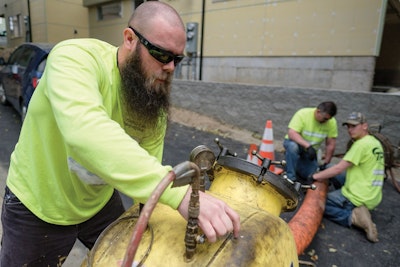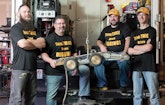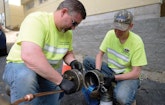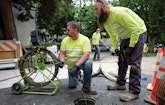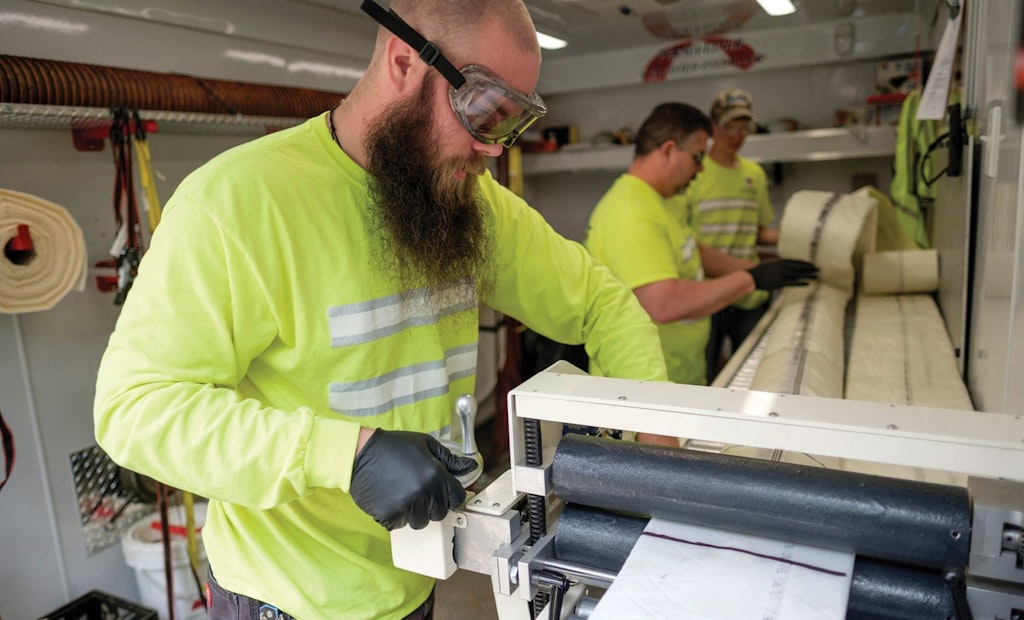
Tryon, Wasmund and Poteet (from left) feed a liner through the roller to impregnate it with resin prior to installation.
There are several reasons why Trenchless Pipe Repairs has emerged as a major player in the Pacific Northwest's pipeline inspection and rehabilitation market. But one factor looms a little larger than the others: Owner Nick Patrick's keen interest in productivity- and profit-enhancing equipment.
“I’m a technology junkie,” says Patrick, 44, who established TPR in 2011 after working for more than a decade for two utility service companies. “I’m always researching new products that will allow us to expand services.
“Everything I do is calculated,” he adds. “We don’t buy equipment unless we’re sure we can use it and pay it off. Nowadays in this industry, new products are coming out left and right. You just have to figure out what’s good and what’s not.”
Other factors have also figured heavily in the company’s success, including a slow but strategic conversion from mostly residential work to large commercial and municipal projects, heavy use of social media to build TPR’s brand recognition, and specializing in tackling the more-difficult jobs — a niche that commands better profit margins. “We’ve basically separated ourselves as a specialty contractor,” he says.
“I pay attention to small details,” he says when asked about his most valuable attribute as a businessman. “I’m also very driven. When I start something new, I always strive to be the best at it.”
The results speak for themselves. Patrick generated about $247,000 in gross revenue during his first year in business, employed one person, owned only a 2007 Ram pickup truck and a 1995 GMC box van, and served just the local residential market. Today, Patrick employs eight people, owns roughly $1 million worth of equipment and vehicles, and expects to gross about $2.2 million this year serving customers throughout Washington and Oregon.
Utilities 101
Patrick began his career in 1995 when he took a job with a utility-locating and -marking company in Seattle. In 2000, he gained more experience by transferring to a sister company that offered pipeline inspection services and lateral lining. In 2009, he expanded his knowledge by partnering with another contractor to start a cured-in-place pipe lining business that focused on sectional, lateral and lateral-connection lining. Two years later, the duo dissolved the partnership and Patrick established TPR, focusing primarily on lining residential sewer laterals.
Patrick purposely targeted the residential market. Reason 1: He was able to establish business relationships with plumbers who hired him as a subcontractor. Reason 2: a little thing called cash flow.
“Cash flow is extremely important when you’re starting out small with nothing,” he points out. “It’s always a problem if you have a huge capital investment (in pipe lining equipment), which I did. Getting paid up front allowed me to pay for things as I went along and slowly expand the business. By getting money up front, I could still make the payments on my equipment, but also throw additional money into marketing.”
After Patrick established the company in the marketplace, he moved into the industrial and municipal markets. While he concedes it takes longer to get paid in those sectors, there’s upside, too: better profit margins.
Game-changer
Today, about 75 percent of TPR’s revenue comes from relining. The company uses a Perma-Liner Maverick system that relies on hot-water curing technology. Drain cleaning and inspection generates the remaining 25 percent. But a new market — robotic cutting service for removing drainline obstructions — is slowly transforming his company once again.
This emerging sector graphically illustrates the value of investing in new technology in order to attack a new market niche. In this case, a construction boom in Seattle and the Pacific Northwest is driving demand for the service. As contractors frame up foundations for large buildings, they also periodically drive in tieback anchors to more firmly affix the foundations to the ground.
“While they’re drilling, they’re hitting sewers and filling them with grout that’s used to anchor the tiebacks,” Patrick explains. The solution? A Schwalm Robotic Talpa FSR 2060 that can remove grout and concrete from sewer lines with a retrofitted 3,000 psi water jet that doesn’t damage the mains. Moreover, the unit includes a video camera that allows the operator to watch the robot at work.
The Schwalm unit is housed in a camera truck, built on a GMC Kodiak chassis with an 18-foot van body. The truck also carries an Aries pipeline inspection system.
TPR also owns a 16-foot 2017 Isuzu lateral-lining van built by Perma-Liner Industries; a 14-foot 1995 GMC sectional- and connection-sealing van outfitted with equipment from Perma-Liner, Source One Environmental and Interfit USA; and a 2016 Ram 3500 that carries more Perma-Liner equipment.
In addition to the Schwalm unit, the company owns a Maxi Miller cable machine, made by Picote Solutions for cleaning 4- to 8-inch-diameter pipes; a trailer-mounted water jetter built by Jetters Northwest (a division of Seattle Pump & Equipment) that can clean 2- to 6-inch-diameter lines (12 gpm at 3,000 psi); a 2015 Dodge ProMaster equipped with an Envirosight Rovver X Verisight Pro cameras, also made by Envirosight; a RIDGID NaviTrack pipeline locator; and a lateral reinstatement cutter made by IMS Robotics GmbH.
Keys to growth
Using advanced technology isn’t the only reason for TPR’s growth. Patrick also credits innovative marketing, such as the two-day-long open houses he holds for municipal officials, general contractors and engineers. The main events: Live demonstrations of TPR’s latest investments in technology at work, such as the Schwalm Robotic unit.
“They basically get to see all the equipment we have and what we can do with it,” he says. “I’ve been holding these open houses since day one and we try to do two or three a year.” All the demonstrations are performed above ground with sewer line mockups and each one is preceded by a brief PowerPoint presentation.
Patrick concedes that two days is a lot of time to invest. But he points out that it’s easier to have a group of people come to his facility for demonstrations than it is to make separate visits to each person who attends — typically about two dozen people. Including a luncheon that Patrick holds on both days, the time commitment for customers comes to about five hours a day.
Creating a family atmosphere for employees also yields benefits. “We treat everyone like family, not just a number,” Patrick notes. “When you treat employees like family, they’re more interested in the company and take more pride in what they do. They realize that we’re not only trying to grow the company, but also trying to give them the kinds of technology that allow them to grow as people — build a career.”
Looking ahead, Patrick anticipates more growth but never wants to grow so much that he needs more than 20 employees. At that size, he’d start to worry about quality control and losing the friendly, family-like environment he’s created over the past six years.
“I love being a smaller, family-run company,” he says. “But the bigger you get, the more difficult that is to maintain. So I’d like to keep things smaller.
“Three to five years down the road, I’d love to be able to sit here and basically have the company run without me. But on the other hand, you never know where things will lead.”
Social media helps build a brand
Nick Patrick — the owner of Trenchless Pipe Repairs in Sumner, Washington, uses social media to give potential customers a vivid look at his company’s high-tech capabilities. He believes it showcases his services much more effectively than a website.
To Patrick, 44, websites are fine for disseminating technical information. But they don’t even come close to showing customers what his company is all about, compared to the photos and videos he regularly posts on Facebook, YouTube, Twitter and LinkedIn.
“You can look at different websites and they all pretty much look the same — mainly just a bunch of words,” Patrick explains. “But with social media, you can post pictures and tell little stories about what you’re doing.
“We still use our website as a place for customers to get technical information,” he continues. “But for marketing, it’s all about social media. People can see the actual jobs you’re doing and the equipment you’re using, and it’s all in real time. They learn more about your company that way than via our website. That’s why I’ve blown up my company on social media.”
Patrick estimates that social media generates up to 30 percent of his company’s job leads. And best of all, most social media platforms don’t cost a penny. One exception is a premium membership package from LinkedIn that costs $550 a year. But even that expense is worthwhile; Patrick says he’s ranked among the top 10 percent of contractors in the pipe lining industry on LinkedIn. And LinkedIn has led to connections with people all over the world.
“Engineers and municipal officials can see everything we do,” he says, explaining the value of social media. “There’s an immediacy to it because you can post things right away in real time. You can’t really flood a website with photos, but you can flood social media with photos.
“Then they talk to somebody about what they saw,” he continues. “And then those people, in turn, talk to even more people about it. … In our case, this company in Seattle that has a robot that can cut obstructions from sewer lines.”
While it’s great that potential customers can see that TPR uses cutting-edge technology to serve its customers, doesn’t that also provide valuable intel for competitors? “Yes, it shows them what I’m doing,” Patrick concedes. “But there’s nothing I can do to stop that. I’m more concerned about marketing what we do because that’s what helps build our reputation.”
There’s no need to feel daunted about using social media, either; Patrick says he’s completely self-taught. And he has his field technicians trained well, too. If Patrick can’t get to a job site, his technicians take photos and text them to his cellphone. From there, he posts them right away on social-media platforms. “People love to see the cool things we’re doing.”
